The Hardest Part of Collecting is Beginning, Part 4: Finding U.S. Stamps in the Catalogue
By John M. Hotchner
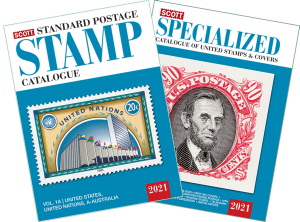 In the last three editions, this column looked at what it takes to get started as a stamp collector, choosing what to collect, and how to get stamps for your collection, and how a Scott Standard Postage Stamp Catalogue can help you identify your stamps and build your collection. This may also help if you don’t have a catalog, and are simply trying to find the correct box in a stamp album where your stamp should be placed.
In the last three editions, this column looked at what it takes to get started as a stamp collector, choosing what to collect, and how to get stamps for your collection, and how a Scott Standard Postage Stamp Catalogue can help you identify your stamps and build your collection. This may also help if you don’t have a catalog, and are simply trying to find the correct box in a stamp album where your stamp should be placed.
Let’s start by picking nine U.S. stamps that we need to find among the nearly 5,500 U.S. issues shown in the Catalogue. We’ll stick to stamps issued after 1890, as they are the stamps most likely to find their way to a beginner. Looking at these stamps, sometimes with a magnifier, will give us clues to help us find them in the catalogue or album.
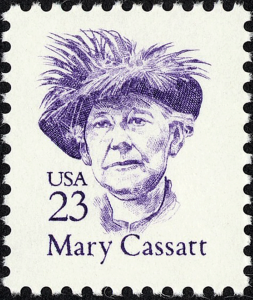 The 23¢ purple stamp showing Mary Cassatt has a couple of helpful attributes in addition to Cassatt herself. It is an airy design with lots of white background, identifies the country of issue as “USA” and it has a value of 23¢.
The 23¢ purple stamp showing Mary Cassatt has a couple of helpful attributes in addition to Cassatt herself. It is an airy design with lots of white background, identifies the country of issue as “USA” and it has a value of 23¢.
But the subject may be all we need, as the catalogue has a “Subject Index of Regular, Commemorative & Air Post Issues”. (It also lists U.S. Semi-Postals, but does not include them in the title.) There we find that stamps featuring Mary Cassatt are numbered 1322, 2181, 3236o, and 3804-3807. It is a simple matter to check each of those numbers until we find our stamp. In doing that we will also find that Mary Cassatt was an artist, and the stamps mostly picture her iconic paintings. But Scott number 2181, issued in 1988 as part of the Great Americans series is a match for our stamp.
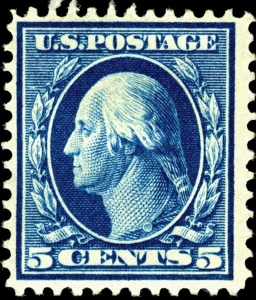 If we did not have the subject index, the design itself would be a great pointer. American stamps into the mid-20th Century tended to have little white space, single color designs, and a lot of fancy elements that filled the design space. A good example is the 5¢ George Washington stamp. It says across the top “U.S. Postage,” has laurel leaves around the portrait of Washington, spells out the word “Cents,” and has ribbons under the portrait. This level of complexity marks this stamp as being from the first part of the 20th Century. Not only were the designs “heavy,” but they were repetitive. Almost every U.S. stamp issued into the 1920s pictured Washington, Ben Franklin, or a portrait from a very limited cast of characters emphasizing presidents, major political figures or military heroes. Another feature to notice between the 23¢ Cassatt and the 5¢ Washington is the method of showing the country name: “U.S.” or “USA” replaced the spelled-out version or “U.S. Postage” on most stamps starting in the mid-’60s. So, the heavy design and the “U.S. Postage” again mark the 5¢ stamp as something from early in the 20th Century. Here the Index is not a lot of help as there are dozens of stamps picturing or honoring George Washington. Leafing through the catalogue for the early part of the century will quickly identify the set of 1918-1922 Washington-Franklin stamps as being where the 5¢ Washington comes from. The problem is that there are no fewer than 14 different versions of this 5¢ design — sheet stamps, coils, different perforations, different watermarks, different papers. (And the 5¢ is easy compared to the 1¢, 2¢, and 3¢ stamps of the Washington-Franklin series!)
If we did not have the subject index, the design itself would be a great pointer. American stamps into the mid-20th Century tended to have little white space, single color designs, and a lot of fancy elements that filled the design space. A good example is the 5¢ George Washington stamp. It says across the top “U.S. Postage,” has laurel leaves around the portrait of Washington, spells out the word “Cents,” and has ribbons under the portrait. This level of complexity marks this stamp as being from the first part of the 20th Century. Not only were the designs “heavy,” but they were repetitive. Almost every U.S. stamp issued into the 1920s pictured Washington, Ben Franklin, or a portrait from a very limited cast of characters emphasizing presidents, major political figures or military heroes. Another feature to notice between the 23¢ Cassatt and the 5¢ Washington is the method of showing the country name: “U.S.” or “USA” replaced the spelled-out version or “U.S. Postage” on most stamps starting in the mid-’60s. So, the heavy design and the “U.S. Postage” again mark the 5¢ stamp as something from early in the 20th Century. Here the Index is not a lot of help as there are dozens of stamps picturing or honoring George Washington. Leafing through the catalogue for the early part of the century will quickly identify the set of 1918-1922 Washington-Franklin stamps as being where the 5¢ Washington comes from. The problem is that there are no fewer than 14 different versions of this 5¢ design — sheet stamps, coils, different perforations, different watermarks, different papers. (And the 5¢ is easy compared to the 1¢, 2¢, and 3¢ stamps of the Washington-Franklin series!)
 How to tell which one you have? This is where you will have to learn to use some of the implements that are essential to the collecting of U.S. stamps: a perforation gauge, watermark detector, a magnifier. But once you learn to use them, you are no longer a beginner! The easiest way to master these implements is to learn from another collector. I’ve touted elsewhere in this series the value of joining a stamp club. Nowhere is that more useful than when it comes to learning the basics of collecting.
How to tell which one you have? This is where you will have to learn to use some of the implements that are essential to the collecting of U.S. stamps: a perforation gauge, watermark detector, a magnifier. But once you learn to use them, you are no longer a beginner! The easiest way to master these implements is to learn from another collector. I’ve touted elsewhere in this series the value of joining a stamp club. Nowhere is that more useful than when it comes to learning the basics of collecting.
But you can start on your own by reading the introductory material in the catalogue, and reading the instructions that come with your philatelic instruments. In the next column, I will provide some guidance on where these implements are available, and some hints on how to narrow down the complicated Washington-Franklins and other such issues where there are multiple listings for stamps of the same basic design.
Let’s summarize, and provide a few more general guidelines to help you find your stamps in the catalogue:
(a) The vast majority of U.S. stamps up until the mid-1950s are single color stamps. There are plenty of single-color stamps after that, but as time went on improved printing technology allowed a greater and greater percentage of U.S. issuances to be produced as multi-color stamps.
(b) Classically designed stamps give way to more colorful, airy designs that some would call poster art starting in the late 1950s.
(c) Use a magnifier to look for dates in the design of stamps, as many of them commemorate an event or note the year of issue in the design. Since 1995, the U.S. Postal Service has actually added the year of issue in the mar- gin at the bottom of almost all designs.
(d) While we continue to see founding fathers and government officials on small mail-use definitive stamps today, the range of people and other content is considerably broadened starting with the Liberty issue of the mid-1950s. Christmas stamps begin in 1962. U.S. flag stamps on small definitives begin in 1963. And methods of transportation are included starting in 1981,
(e) Modern stamps, starting in the early 1970s, much more often than not abbreviate “United States” to “U.S.” or “USA” instead of writing them out, or using “U.S. Postage.”
(f) Often the first place to look for your stamp is in the Stamp Subject Index in the Scott Catalogue. If there are many numbers listed for a given subject, check the numbers to see if you can find a match. If there are many numbers listed for a given design, you may need to use stamp collector implements to determine which stamp you have.
(g) Because they are used more often than odd values, remember that U.S. stamps issued for First Class postage predominate, and that almost all commemoratives are issued at the First Class rate. Keep in mind that U.S. rates from 1890 on were in the following progression: 2¢, 3¢ (WWI rate), 2¢ (1919), 3¢ (1932), 4¢ (1958), 5¢ (1963), 6¢ (1968), 8¢ (1971), 10¢ (1974), 13¢ (1975), 15¢ (1978), 18¢ (1981), 20¢ (1981), 22¢ (1985), 25¢ (1988), 29¢ (1991), 32¢ (1995), 33¢ (1999), 34¢ (2001), 37¢ (2002), 39¢ (2006), 41¢ (2007), 42¢ (2008), 44¢ (2009), 45¢ (2012), 46¢ (2013), 49¢ 2014), 47¢ (2016), back to 49¢ (2017), 50¢ (2018), and now 55¢ (2019). And of course there are Forever stamps that began in 2007, and continue today.
So, if you have a stamp with one of these denominations, and the design and design elements described above comport with the complexity-to-simplicity time line, then the era of that First Class rate may be the first place to look.
If you are stumped after trying these guidelines, try to find a collector with more experience who can help you; most readily at a local stamp club, or at a nearby bourse or stamp show where there are collectors and dealers. [You can also ask in 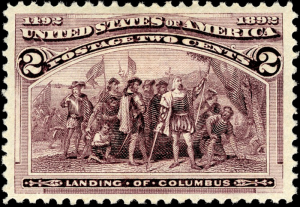 The Virtual Stamp Club‘s Facebook group.]
The Virtual Stamp Club‘s Facebook group.]
Now, let’s apply the guidelines to more stamps. The 2¢ purple commemorative has the dates 1492-1892 at top, and is a heavy design. “United States of America” is spelled out, and the scene description “Landing of Columbus” is noted in the Index. That is more than enough to find that this is an 1893 stamp, with Scott No. 231.
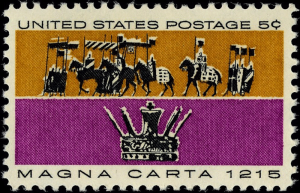 The multi-color 5¢ “poster art” stamp labeled “Magna Carta, 1215” is a commemorative, so will most likely be found in the 5¢ rate era. “United States Postage” is spelled out. The label is also listed in the Index, where we learn it is Scott No. 1265.
The multi-color 5¢ “poster art” stamp labeled “Magna Carta, 1215” is a commemorative, so will most likely be found in the 5¢ rate era. “United States Postage” is spelled out. The label is also listed in the Index, where we learn it is Scott No. 1265.
The 2¢ red stamp with the light bulb [below] has a dense design with lots of repetitive design elements. It is a commemorative (for “Edison’s First Lamp,” so the face value likely equates to the First Class rate. Edison is listed in the Index, so that narrows down the choices to Scott Numbers 654, 655 and 656. This is not a coil, with two matching straight edge sides (as defined in the Catalogue’s Introduction), so you will need a perforation gauge to determine whether this is flat plate-printed, perf 11×11, #654, or rotary press-printed, perf 11×10-1/2, #655. (It is the former.)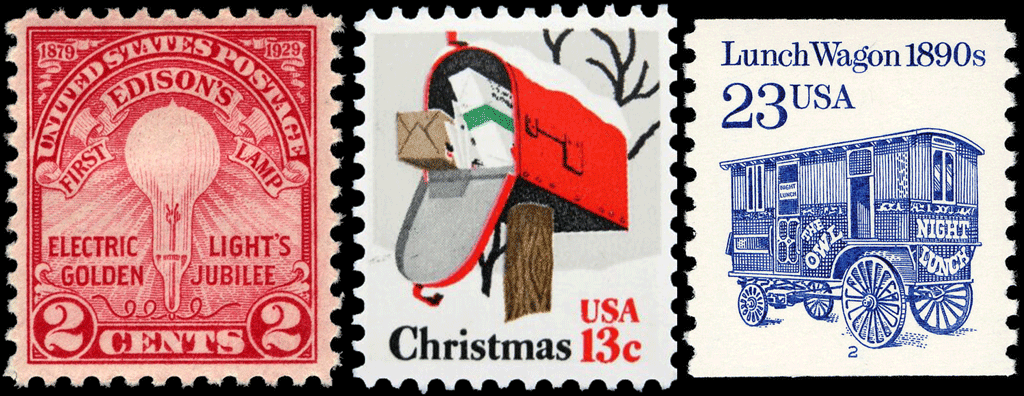
The multicolor “Christmas” issue [above] with a “13¢” face value, has to be post-1962, and likely in the 13¢ First Class rate era. “Mail Box” is not in the Index, but there is enough information to find this stamp as part of the Christmas issues released in 1977, Scott #1730.
Even though it is a single-color stamp, the “23usa” “Lunch Wagon” stamp [above] is a simple design with lots of white space, and is a coil, so it will probably be found among the 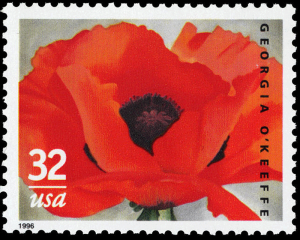 Transportation coil series, which began in 1981. It is in the Index, as Scott #2464.
Transportation coil series, which began in 1981. It is in the Index, as Scott #2464.
The 32¢ multicolor Georgia O’Keeffe stamp featuring her painting of a Red Poppy has the year of issue “1996” in the lower left corner just below the design. Between that and the fact that O’Keefe is listed in the Index, there is no problem determining that this is Scott #3069.
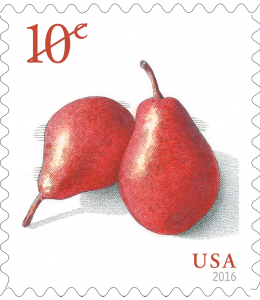 Finally, the 10¢ Red Pears is a design with lots of white space. The Index does not list Red Pears, but does list several stamps under “Pears”. Looking at the candidates we see that the design was first used for a coil in 2016, but our stamp is not a coil, and it has the date “2017” in the lower left corner. So it is the sheet issue (with perforations around all four sides) identified as Scott #5178.
Finally, the 10¢ Red Pears is a design with lots of white space. The Index does not list Red Pears, but does list several stamps under “Pears”. Looking at the candidates we see that the design was first used for a coil in 2016, but our stamp is not a coil, and it has the date “2017” in the lower left corner. So it is the sheet issue (with perforations around all four sides) identified as Scott #5178.
There will still be some challenges among the stamps you have to find, but the great majority of U.S. stamps can be identified using these guidelines.
Should you wish to comment on this editorial, or have questions or ideas you would like to have explored in a future column, please write to John Hotchner, VSC Contributor, P.O. Box 1125, Falls Church, VA 22041-0125, or email, putting “VSC” in the subject line.
Or comment right here.




How do I know if my Washington 1cent stamp is worth more then then the other , or my Thomas Jefferson 1,2 on up stamp s. Some are shaped and printed different but have the same face value but look different and some have dried ink splatter and some have different feel. Please advise. Also how do I sell my stamps? Thank you,
You really need to invest in a perforation [“perf”] gauge and some watermark fluid & tray. I am strongly encouraged by the fact that you noticed they can actually FEEL different from one another! Make certain, however, that your hands are extremely clean and dry because nothing soaks up fingertip oil more completely than a stamp. Stamp tongs, btw, are a must.
Best wishes!
John, you had a hand in the initial validation of what I’m now calling the “Teardrop” Dunbar (#1554) stamp of 1975. It’s currently up (as a Block of 9, with the “Teardrop” stamp at the center) for auction on eBay (item #363071692774) and, in the details, I’ve described the role that you played with your Linn’s “U.S. Notes” column.
Also, a hearty congratulations to you for winning the 2020 Neinken award.
Sincerely,
Howard
I got 14 Benjamin Franklin stamps and 15 George Washington one cents stamps on a lot of post cards that could be Billy the kid and his wife and aunt
How can I sell my US stamps and get the best price for it, I tried contacting Sotheby’s to know the procedure sent whattsup photos of my stamps to Shrinivasan their staff in Mumbai but no reply, I know my stamps are rare and expensive Do guide me
Start with my article, “Help! I Inherited A Collection” at http://www.virtualstampclub.com/inherit.html. Although written for U.S. collectors, I think it has some useful tips for everyone. I’m not familiar with the market in India. Here, Sotheby’s would not be the first place I’d contact, and its rep in Mumbai is probably not familiar with stamps. However, it’s important you get an idea of what you have, and how much in demand it is before contacting a potential buyer.
You might also get in touch with India’s overall stamp collecting organization:
Philatelic Congress of India
33A, Chowringhee Road,
5th Floor, Room -13,
“Chatterjee International Centre”
Calcutta- 700071. INDIA.
Phone: +91 9830275515
bagri@iname.com
http://www.philateliccongressofindia.com
I don’t see anything on its site of particular use to you, but I may have missed it. Good luck!